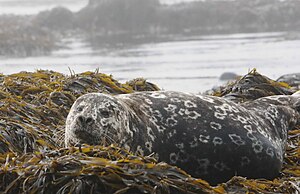Kuril sea dog
| Kuril sea dog | ||||||||||||
|---|---|---|---|---|---|---|---|---|---|---|---|---|

Kuril sea dog ( Phoca vitulina stejnegeri ) |
||||||||||||
| Systematics | ||||||||||||
|
||||||||||||
| Scientific name | ||||||||||||
| Phoca vitulina stejnegeri | ||||||||||||
| JA Allen , 1902 |
The Kurilenseehund ( Phoca vitulina stejnegeri ) is a Pacific subspecies of the harbor seal from the genus of the real dog seals ( Phoca ).
description
The males reach a length of 174 to 186 cm and a weight of 87 to 170 kg. The females are 160 to 169 cm long and can weigh between 60 and 142 kg. At birth, the young are 98 cm long and weigh 19 kg. The Kurilenseehund comes in a light and a dark variant. The light variant has a dark back and a pale belly with dark spots that merge into one another. There are also pale areas around the eyes and muzzle. The dark variant is almost black and has closely spaced points with light rings. It feeds on fish and squid.
distribution
Its distribution area includes Kamchatka , the Sea of Okhotsk , the Kuriles , Hokkaidō and the commanders' islands .
Danger
The Kuril sea dog is endangered in Hokkaido. In the 1940s, the inventory at Cape Erimo was 1500 copies. In 1986 the number decreased to just 350 animals. In 2004 the population recovered to 905 specimens. In the past, the seals were mercilessly shot down by fishermen and hunters, so that in the 1960s there were only 3,000 specimens left. Today the stocks have recovered in a large area of the distribution area, but the main threat is still the fishing nets, in which the animals get caught and then die.
Systematics
In 1883, Leonhard Hess Stejneger discovered a new species of seal at the commanders' islands, which Joel Asaph Allen described in 1902 as Phoca stejnegeri . In 1942, Tetsuo Inukai described the seal populations from the Kuril Islands and northern Hokkaido as Phoca ochotensis kurilensis . In 1964, AN Belkin classified the seals from the Kuril island of Iturup as a new species, Phoca insularis . In 1966, Ian Alexander McLaren considered the taxon described by Inukai to be an independent species, Phoca kurilensis . In 1968, Sergeĭ Vladimirovich Marakov studied the seal populations of the Commander Islands and the Kurils and found that the taxa stejnegeri , kurilensis and insularis are identical. The Kuril sea dog has been a subspecies of the seal since 1977 .
literature
- PJH Reijnders, International Union for Conservation of Nature and Natural Resources Species Survival Commission, IUCN / SSC Seal Specialist Group: Seals, Fur Seals, Sea Lions, and Walrus: Status Survey and Conservation Action Plan. IUCN, 1993 ISBN 9782831701417 .
- Food and Agriculture Organization of the United Nations. Working Party on Marine Mammals: Mammals in the Seas: Small Cetaceans, Seals, Sirenians and Otters. Volume 4 of Mammals in the Seas: Report of the FAO Advisory Committee on Marine Resources Research, Working Party on Marine Mammals, 1982, ISBN 9789251005149 .
- Joel Asaph Allen: The Hair Seals (Family Phocidae) of the North Pacific Ocean and Bering Sea. In: Bulletin of the American Museum of Natural History. 16, pp. 459-499 ( online ).
Web links
- Tagging and measuring of Harbor seals (Phoca vitulina stejnegeri) in Erimo Cape, Japan Online
- Insular seal ( Memento from December 28, 2007 in the Internet Archive ) (English)
- Russian Far East Marine Mammal Research Program description and photos (Russian)
- Description in the Russian Red List (Russian)
